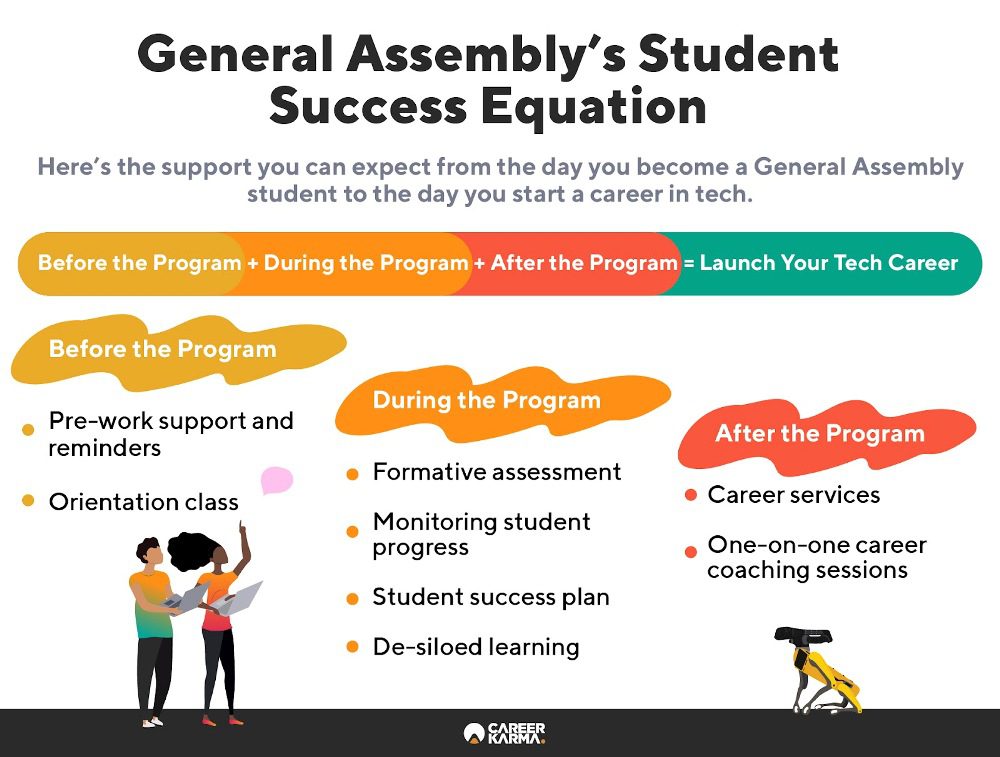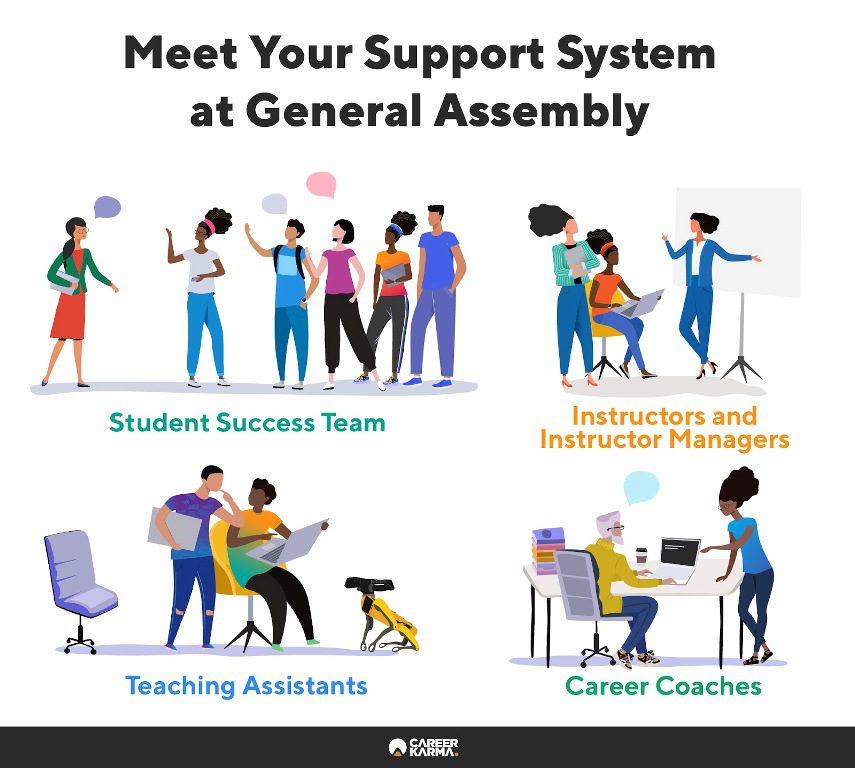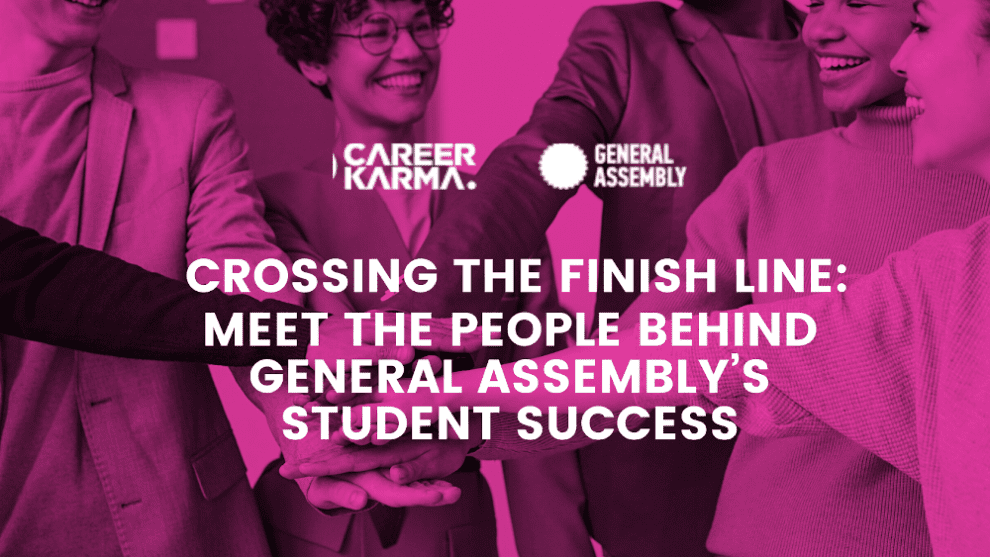Since its inception in 2011, General Assembly has been one of the leading training grounds for tech professionals, with the coding bootcamp boasting job placement rates that consistently cross the 90-percent mark. Behind these numbers lies the constant collaborative effort between the entire General Assembly team and their students.
For General Assembly, student success isn’t something you achieve alone. It’s a collective responsibility.
Learning Success: Increasing Relevance of Student Support
Working your way through four years of college and incurring student debt yet not having a job to show for at the end is nowhere near acceptable. But for 30 percent of college graduates, this is their reality.
Analysis from the Pew Research Center reveals that among the College Class of 2020, 31 percent of graduates remain unemployed. While the high unemployment rate may simply be chalked up to the misfortune of graduating into the brunt of a pandemic, previous numbers had already signaled an alarming trend in the traditional learning space.
In 2019, 22 percent of college graduates reported unemployment, while others who secured jobs struggled with underemployment. According to the Federal Reserve Bank of New York, around 41 percent of college graduates by the end of 2019 were working in jobs that don’t require degrees.
To top it off, a recent study from Cengage reports that nearly half of college graduates don’t feel like they got what they paid for in college. Among them, one in five graduates believes they don’t have the skills needed to land a job that aligns with their background.
If you consider the rising cost of college, the $40,000 student debt—which is the average amount that student borrowers owe—and recent student outcomes, it’s easy to think that getting a good return on education investment is a rarity, not the norm.
Coding bootcamp General Assembly turns this notion on its head by proving that collective student success isn’t something left to chance. With deliberate planning and consistent support, it’s possible.
How Does General Assembly Lead Students to Success?

Two ideas govern General Assembly’s approach to student success. One, job readiness and employment should always be front and center of the entire learning experience. Two, it takes a community to produce high-performing software engineers.
When put into practice, you get a school where meaningful learning is always taking place.
Student Support Before the Immersive Program
At General Assembly, students gain access to personalized support and mentorship even before the first day of classes. Taking care of this is the school’s Student Success Team.
The Student Success Team is joined by members who ensure that the students, instructors, career coaches, and the staff have all the tools and support they need to create quality learning experiences.
“During the onboarding process, all students complete a series of tasks, which we refer to as pre-work, to ensure that they have a baseline understanding for the course that they’re going to take,” says Michelle Cohen, General Assembly’s Student Success Manager.
“For example, [if a student is taking] the Data Science Immersive, we make sure they have some basic understanding of Python, math, and statistics. The goal is to make sure they’re comfortable with some of the topics that they’ll be going over in class.”
“And so, we have pre-work deadlines to ensure they have sufficient time to complete their pre-work and are getting prepared for the course,” says Michelle. To make sure students hit these deadlines, the Student Success Team gives constant reminders and checks whether students are making good progress or if they need further guidance.
“We also run an orientation before class begins to give students the opportunity to meet their classmates, ask any questions before their first day, and feel comfortable in the remote environment, especially using tools like Zoom and Slack.”
Put simply, the Student Success Team makes sure that students are set up for success the moment they officially join General Assembly.

Student Support During the Immersive Program
Student support at General Assembly grows four-fold once classes begin. “There are a lot of folks behind the scenes,” says Michelle: the Student Success Team, instructors and instructor managers, teaching assistants, and career coaches. All of them work together to create a more cohesive and comprehensive stream of support as you go through the program.
1. Formative Assessment and Monitoring Student Progress
The Student Success Team serves as the glue in this support system. “I meet with our instructors, instructor managers, and career coaches every week to check in on student progress and see if any of the students need additional support,” says Michelle.
“We see to it that their assignments, projects, and attendance are all up to date… So, we use tangible assignments to benchmark progress.” If a student appears to require further support, the first step the school takes is to establish a first-level connection with the student through the instructor.
“Sometimes, the student might share that there’s a personal problem going on, which has prevented them from completing their work. Sometimes they might share that they’ve been really confused with the content.”
“So that becomes an opportunity for the instructor to encourage the student to attend office hours, either with them or with the teaching assistant.”
2. Student Success Plan
This is also where the team introduces a tool called the Student Success Plan. The Student Success Plan is a personalized document that outlines the resources that students can use to overcome whatever challenges they’re facing while training.
There are two ways for a student to get ahold of the Student Success Plan. It can be proactively sought out by the student or given by the support team—instructional team and the Student Success Team—based on the student’s current assignments and performance in the course.
Depending on what the student is struggling with, the Student Success Plan may contain resources on project management, time management, or supplemental resources and tutorials for further learning.
For example, if a student has trouble with project planning, the team puts together a Student Success Plan that highlights tools and resources at their disposal. This also includes actionable steps that students can take, like scheduling regular one-on-one tutorials with their instructor or teaching assistant who can help them scope down the way they tackle projects.
“That allows us to talk about strategies like scaffolding deadlines if they have one big project due, rather than leaving them feeling unsure of how to complete everything in a week beyond the rubrics and sets of instructions already given,” says Michelle.
“It’s a way to let the students know, ‘Here’s what’s available to you.’ It’s also a collaborative opportunity to ask them, ‘What has or has not worked for you in the past?’ says Michelle. “It’s just really trying to segment and break things down for some students who might need a little bit more support.”
3. De-Siloed Learning
Learning at General Assembly never occurs in a silo, regardless of whether classes are delivered in person or online.
“We use Slack really closely,” says Michelle. “Instructors post questions on Slack and students respond in the thread. So that’s one of our opportunities to check in again and see how folks are understanding the material.”
Zoom is also a regular feature in the General Assembly learning experience. “We have students work on a collaborative assignment and put them in Zoom breakout rooms,” says Michelle. “They can also hop on Zoom if they’re working on a homework assignment on the weekend and find others doing the same thing.”
“I think figuring out how to make the course feel interactive even in the online environment is something we’ve gotten great at and our students are really enjoying the online experience,” she adds.
By leveraging all the available tools, General Assembly makes sure that students are exposed to multiple perspectives and that they can learn at any time, whether it’s during class or on the weekends.
Student Support After the Immersive Program
Graduating, though important, is not the end goal at General Assembly. Instead, it’s finding gainful employment with the skills you learned from the program. The school helps students get there through numerous career services that they’ll have access to well before they receive their certificates.
Throughout the program, they get to attend weekly sessions with their career coaches. “[The career coaches] talk about [how students can] define their brand or build their network, among others,” says Michelle, “so that it’s not all left to the end” at the risk of overwhelming the students.
“We try to incorporate it throughout the course so they can also build a relationship with their career coaches and approach them if you have questions or concerns.”
Instructors also collaborate with the career coaches to give some insights about the students’ strengths, which may be relevant to their job hunt.
“For example, if the instructor sees that a student is strong with presenting ideas, they share that with the student’s career coach. That way, the career coach knows what skill the student can highlight when applying for jobs,” Michelle explains.
Key Takeaway
General Assembly is there with you, from the day you officially become a student to the day you start a career in tech. Everyone you interact with—whether it’s your instructor, instructor manager, career coach, success coach, or other staff— plays a part in helping you cross the finish line.
The success of the General Assembly community is reflected in the school’s impressive outcomes. A deep dive into General Assembly’s student outcomes report shows that 86 percent of the students completed their Immersive training in 2018. And 91.4 percent of those who participated in General Assembly’s job search program thereafter found jobs within 180 days.
The following year, the school maintained its strong performance with an 85 percent graduation rate and a 90.5 percent job placement rate 180 days after the completion of the program.
Ten years since its inception, General Assembly has managed to deliver on its primary goal: to produce tech professionals that can compete and find their place in the workforce. These General Assembly reviews confirm it.
Moving Forward: Student Success, for All
The General Assembly community moves forward as one with its strong built-in support system. And at a time where uncertainty and unexpected changes dominate the workforce, getting the right kind of support is a key differentiator to your career success.
Success doesn’t have to be achieved alone; you can have an entire community rooting for you. See what General Assembly has to offer and be part of a community that puts student success front and center.
About us: Career Karma is a platform designed to help job seekers find, research, and connect with job training programs to advance their careers. Learn about the CK publication.




